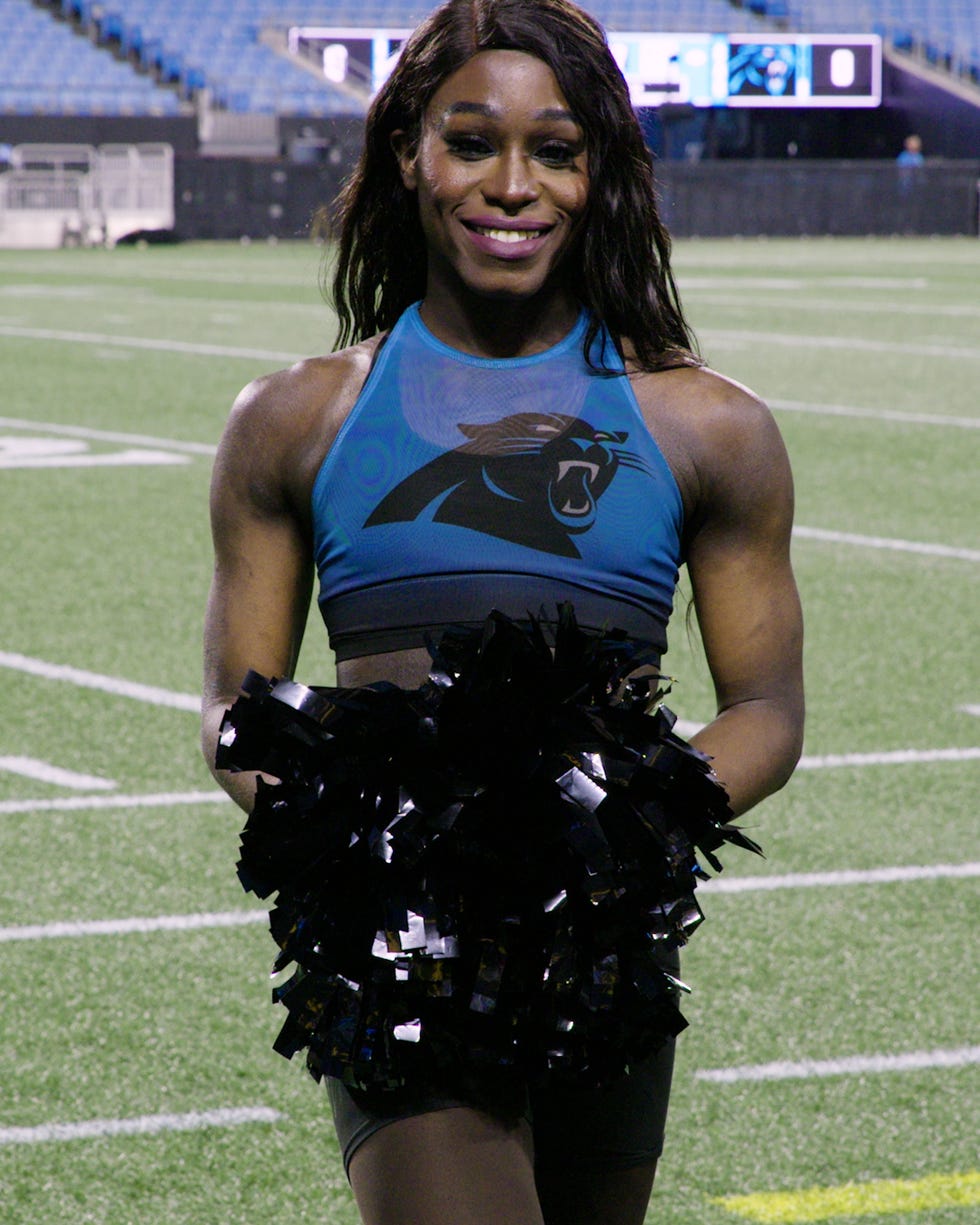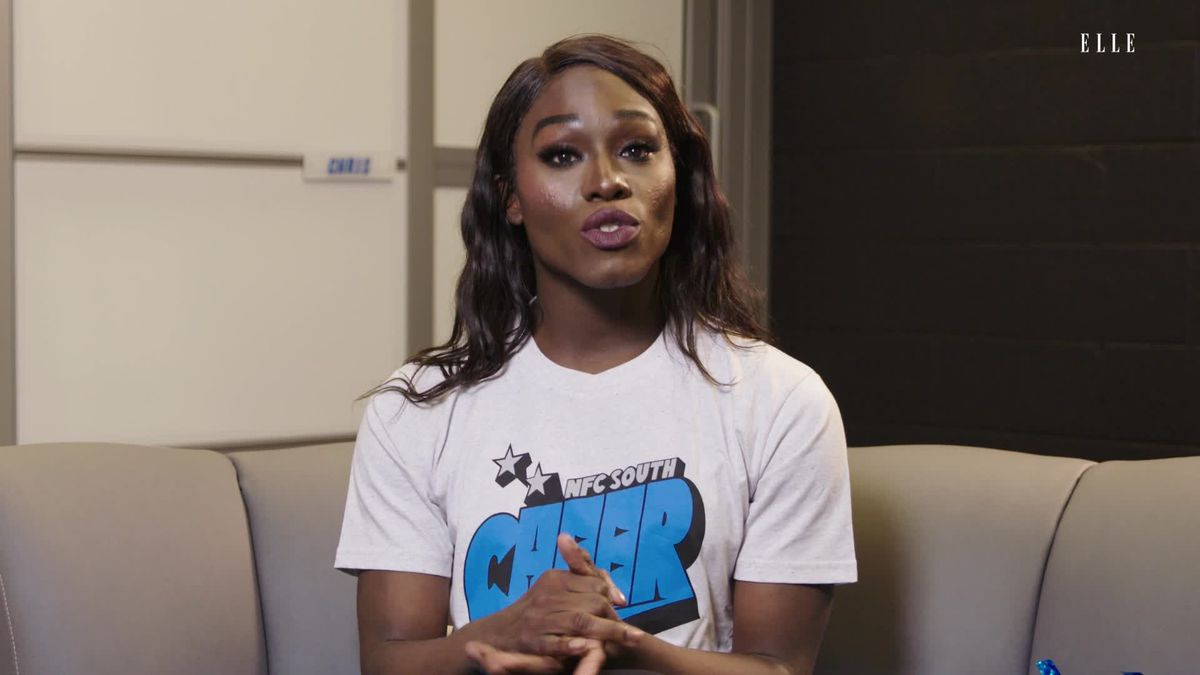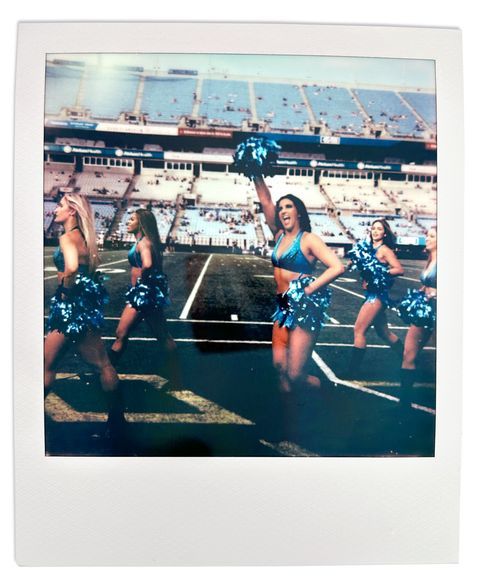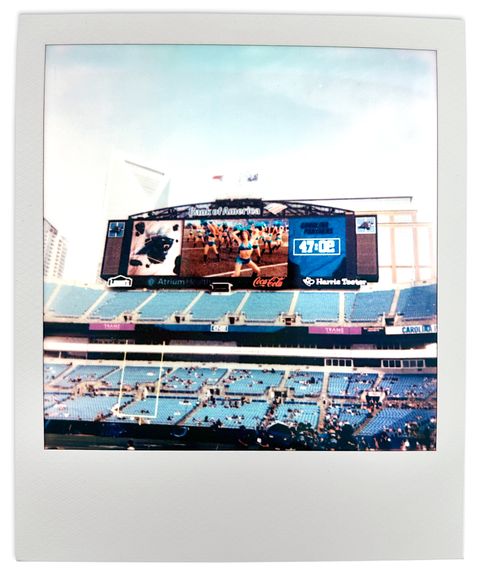Loud and Proud
You know what she looks like. Her hair is blonde, her waist is small, and her skin is almost always white. She’s Torrance Shipman in Bring It On. She’s Quinn Fabray from Glee. But, Justine Lindsay says with a laugh, “she’s definitely not me.” Lindsay, 30, is the first openly transgender woman in NFL cheerleading. She is a sideline crusader, an agent for change from within the machoest of macho sports. And it’s not a position she takes lightly: “But I am a cheerleader,” Lindsay adds, “so I do it with a smile on my face.”
When Lindsay made the Carolina Panthers’ TopCats squad last year, she upended decades of deeply-rooted stereotypes about cheerleaders. For many football fans, her presence in the stadium has symbolized the start of a new chapter for NFL cheer, one where “it’s okay to be your most authentic self,” Lindsay says. Since then, she has started a podcast about her experience, written a viral essay on trans rights, and spoke at a GLAAD event spotlighting inclusion in professional sports. As transgender voices continue to be silenced all across the country, Lindsay is making hers louder than ever.
At times, her courage comes at a cost. Dealing with social media bullies and intolerant football fans can feel like a challenge to her humanity, but Lindsay believes it is a price worth paying. “Everything that I’m going through now, it’s bigger than me,” she says. “I’m setting things up for the younger generation. No one is going to stop this show.”
In early August, Lindsay invited ELLE to her home. Not her physical house, but the place she feels most herself: The Bank of America stadium in uptown Charlotte, where the TopCats perform. Fresh off practice, Lindsay was in the locker room with her teammates getting ready for the evening’s 2023 season kick off event. Ice Spice blasted from a portable speaker. Sparkly eyeshadow palettes, red lipsticks, and contour kits were being tossed around like fliers from a pyramid formation. At one point, an unofficial twerk contest was held. As the squad shimmied into blue and white spandex two-pieces, someone yelled out about a missing pair of pom poms. “We’re chaotic,” Lindsay says with a smile, “but we’re family.”
Her actual family members drive in from all over North and South Carolina to attend almost every game. Lindsay, who grew up in the Charlotte suburb of Dilworth, says she feels at ease in the scrum of a sports locker room thanks to a childhood spent playing sports with older siblings and a gaggle of cousins. Before cheerleading, dance took center stage in her life. She was five years old when the Alvin Ailey American Dance Theater came to town performing Revelations, the company’s signature piece using African-American spirituals and song-sermons. “Seeing people that looked like me… and how they were able to move their bodies, well, it really stuck with me,” Lindsay remembers. “I was like, ‘Dang, I could do that.’”
Her father, a former college football player, hoped she’d follow in his footsteps, but her mother enrolled her in ballet instead. “He never really understood why I wanted to dance,” Lindsay says of her father. “He was like, ‘Is that who you are?’” Dance didn’t define her, but it did help her come to terms with what she’d always suspected deep down.
At 14, Lindsay was selected out of a group of 100 kids to attend the famed Debbie Allen Dance Academy on scholarship in Los Angeles, which counts Disney Channel stars among its alumni. She moved cross-country by herself and easily settled into a new community of young creatives. “I was around people who were open about being who they are,” Lindsay says. “I became more comfortable asking, ‘Who am I?’” By the time she turned 18, she had found the answer: “I was always Justine.”
Nothing is uniform about coming out as transgender. Everyone’s process is unique, shaped by the safety of their environment and how comfortable they feel expressing themselves. For Lindsay, it was less about discovering herself and more about helping others discover her. “When I told my mom, she was like, ‘Okay, well, can you help me put my lashes on now?’” Lindsay remembers. “I think my dad always knew, but there was a denial stage, which every parent, whether you’re the mother or the father, will have. It’s that moment of, ‘Oh, my God, I don’t want this for my child.’”
After graduating from North Carolina State with a communications degree in 2016, Lindsay moved back to Charlotte and spent the next five years establishing what she calls her new “life as a woman.” She got a retail job at the mall to support herself, and started on hormone replacement therapy. “Getting looks from guys saying how pretty you are, even though that’s not what is important, was validation that I was going in the right direction,” she says. “But I wasn’t hanging out with any other trans women, so I just didn’t know much about [the community].”
Everything clicked after meeting other Black trans women through Charlotte’s tight-knit LGBTQ+ community. “They took me in,” Lindsay says. She quickly became a regular on the Southern queer ballroom circuit, and watched Paris is Burning, the 1990 documentary about New York City drag queens, for the first time. “I was able to figure out the lingo and learned to respect everything that trans women have been through,” Lindsay says. She had never felt more herself, but something was still missing from her new life: Dance.
Lindsay credits one of her new friends for encouraging her to try out for the TopCats, which recruits cheerleaders with intensive dance backgrounds. “I was a little nervous,” she says. But, she was determined to do what she loves most by staying true to who she is. “I want to change the narrative for my trans sisters and brothers, just to [let them] know that if you have a goal, go for it,” she says. “Turn that dream into a reality. Be an NFL cheerleader, or a doctor or a nurse or whatever you set your mind to.”
In the NFL, cheerleaders are high-performance athletes and brand representatives. They dance before games and every time music plays during the game, mastering dozens of intricate choreographies using props like pom poms. And they are expected to meet with season ticket holders, attend private corporate events, and participate in team photoshoots. The life of an NFL cheerleader requires a lot of glitter, but it’s not always glamorous. Most are part-time employees, despite spending countless hours at practice and traveling to games. Some have to pay for their own uniforms, while making little more than minimum wage. Until recently, many were asked to abide by strict handbooks that dictated who they could date and how much they could weigh.
For decades, NFL cheerleaders were also secretly enduring workplace sexual harassment and unsafe working conditions. In the post #MeToo era, a string of new lawsuits against NFL coaches, trainers, and even the league itself, has provided some sense of justice and hope for a better future. The fight is far from over, but the very public reckoning has also led squads to consider rebrands that redefine what it means to be a professional cheerleader. Skirts are longer. Men have joined teams. And, just like Mattel did with Barbie, squads are now promoting dancers’ day jobs as nurses, teachers, and engineers on social media and in promotional videos.
Shaking up the status quo has never been an issue for Lindsay. She showed up to TopCats auditions louder, prouder, and balder than anyone else in the room. “She had a shaved head and so much confidence,” TopCats coach Chandalae Lanouette remembers. “You could tell that she was happy to be in the space with other dancers, and that’s kind of what you look for.” On top of being “ridiculously talented” and “very good at what she does,” Lindsay had “so much joy in performing,” adds Lanouette.
When Lindsay posted about making the team on Instagram (“Cats Out the Bag!” she wrote), the “love” came pouring into her comments section. “Did I think making the team would have that much impact? No, not at first,” she says. “But I just was like, ‘You know what? If I’m going to do this, I’m going to do this.’”
It was clear from her first game that Lindsay is the kind of cheerleader you want rooting for you. She puts her professional dance training to use, approaching the sidelines like a stage—each routine like a performance. She cheers at the top of her lungs, shakes pom poms in perfect rhythm, and leaps high in the air to nail perfect split jumps. “I go at it full force, because I knew that no one [in this space] looks like me,” Lindsay says. “I have to stand out, but I have to stand out for the right reason.” Lindsay is not just a cheerleader, but a leader with cheer. Off the field, she embodies that same infectious energy. “Her presence has spread a lot of joy and love in Charlotte,” Lanouette says, “It’s rippling out to the rest [of the world], which is really beautiful.”
While many Panthers fans embraced Lindsay, others were, well, confused. “People were like, ‘Are they going to put her in a dress? Are they going to put her in pants?” Lindsay says. One social media commenter likened her look to one of the prison cheerleaders from the 2005 The Longest Yard remake. “I love that movie, so it actually wasn’t any shade,” Lindsay says. Not so funny were the comments suggesting she had threatened to sue the TopCats if they cut her from tryouts. That, of course, is patently false. “Justine earned her spot on this team,” Lanouette says, “but there are a lot of people that, if it doesn’t fit into a box, they have a hard time understanding it.” What quickly became evident is that Lindsay would not be accepted by everyone. “We are in the South,” TopCats squad member Chris Crawford says, “and there are gender norms and trends that aren’t always recognized, accepted, or acknowledged.”
Social media trolls can be blocked, but it’s much harder to ignore real-life bullies screaming at you full volume from the stands. “I wholeheartedly wish I could tell you that, on game day, all of our fans celebrate Justine,” Lanouette says. “But that’s just not 100 percent the case.” Some fans asking for TopCats selfies request she step out of the photo. One time, Lindsay received a post-game DM so mean that she called Lanouette in tears. “It really made me want to clap back, but I couldn’t do that,” Lindsay says. “I have people looking up to me who could be affected by what I say.” In the worst of times, she turns to dance for comfort. “It takes my mind away from all the stress,” Lindsay says. “I escape, even just for a moment.”
In a year that’s seen record anti-LGBTQ+ hate crimes and an uptick in anti-LGBTQ+ laws, some young athletes are finding themselves forced to choose between who they are and the sport they love. A total of 22 states have banned transgender kids from participating in sports in accordance with their gender identity, with many laws, including in Lindsay’s home state of lina, disproportionately impacting transgender girls by defining them as “biologically male” and categorizing them as a “threat” to fair competition. It breaks Lindsay’s heart knowing that the next generation of transgender children might lose access to outlets like sports which, just as dance did for her, can help people find and express their true selves. “I will fight this until I can’t fight anymore,” she says.
North Carolina’s recently enacted “Fairness in Women’s Sports Act,” which restricts transgender females from playing on female sports teams, doesn’t impact Lindsay’s job as a professional dancer. But it does apply to most middle, high school, and college-level sports teams. North Carolina is also one of 19 states that restrict gender-affirming health care access for transgender children and teenagers. “It saddens me to see it,” Lindsay says.
In response to the onslaught of anti-LGBTQ+ legislation, the Human Rights Campaign, the largest LGBTQ+ civil rights organization, has declared the first-ever national state of emergency for the LGBTQ+ community. Anti-trans rhetoric has spiked to dangerous levels, and “the multiplying threats facing millions in our community are not just perceived—they are real, tangible and dangerous,” the group’s president, Kelley Robinson, said in a statement.
Targeted hate is rearing its ugly head and reverberating around the country, putting people in danger as online threats turn into real-life attacks. According to the Office for Victims of Crime, a branch within the U.S. Department of Justice, one in two transgender people are sexually abused or assaulted at some point in their lives and “the majority of transgender individuals are living with the aftermath of trauma and the fear of possible repeat victimization.”
Around the time Lindsay joined the TopCats, two transgender women were found brutally murdered in hotel rooms not far from the Panthers stadium. “I just thank God that I’m still here,” Lindsay says. “This kind of thing is happening all the time, all over the country, but you don’t hear about it because people with money and power don’t want to talk about it.”
In true cheerleader fashion, it’s rare to see Lindsay without a smile on her face. But the weight of her day-to-day reality isn’t lost on her teammates. “We learned how to navigate the different issues and hardships that we each carry as individuals outside of being TopCats,” Crawford says. “We are a family here, and family protects each other.” As any good cheerleader knows, no formation is complete unless you have a strong support system.
There’s still a lot—a lot—of work to do, but NFL cheer, along with many other cheer squads in other leagues, do seem to be trending in the right direction. On the TopCats, one of the most diverse NFL cheer teams, at least half the squad are women of color. They don’t adhere to a prescribed set of regulated beauty standards and can wear their hair however they choose to.
TopCats veteran Rockii Nelson says that sporting twists on game day makes her feel most confident. “It’s important for us to be able to show [that] this is for everybody, no matter your gender, how you look, anything,” Nelson says. “It’s important for fans to see that.” Lindsay agrees: “We are a true example of what a great team looks like, and other teams can build off of that.”
The 2023 NFL season has officially kicked off, and the TopCats are hard at work hyping up Panthers fans. For Lindsay, football season is her favorite time of year. She gets to do what she loves most in the world, with the people who feel like family, in a stadium that’s like her second home. “Every organization is different, but at the TopCats we care for each other and check on each other and have a genuine love for each other,” she says. Lindsay is proud to represent her home team—and have supported doing it as her most authentic self.
As she continues to defy stereotypes, Lindsay is also pursuing her passions off the field, from a new YouTube channel to cameoing in an indie horror movie. She is always on the move, no matter where she is. The pressure of it all can be overwhelming at times. But Lindsay knows that if things get tough, she can turn to the one space that has always welcomed her with open arms. “As long as these knees can drop it low and bring it up slow, I’ll be dancing,” she says.
Senior Editor
Rose is a Senior Editor at ELLE overseeing features and projects about women’s issues. She is an accomplished and compassionate storyteller and editor who excels in obtaining exclusive interviews and unearthing compelling features.











